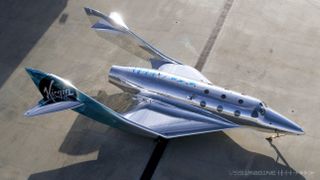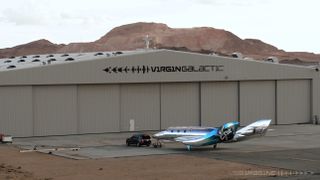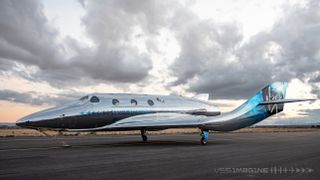Virgin Galactic now has a fleet.
The company today (March 30) unveiled its second piloted space plane, a shiny silver vehicle called VSS Imagine.
Like Virgin Galactic's other spacecraft, VSS Unity, VSS Imagine is designed to take people and scientific experiments to and from suborbital space. However, the newcomer is the first of the next-generation SpaceShip III line, which features upgrades that will "enable improved performance in terms of maintenance access and flight rate," company representatives wrote in a statement today.
Video: Virgin Galactic's Richard Branson unveils SpaceShip III

The SpaceShip III design also features a change that, while dramatic, is merely skin-deep — a mirror-like livery that reflects the vehicle's surroundings, from the ground all the way up to space and back.
"As a SpaceShip III class of vehicle, Imagine is not just beautiful to look at but represents Virgin Galactic's growing fleet of spaceships," Richard Branson, founder of the Virgin Group, said in a statement today.
"All great achievements, creations and changes start with an idea," the billionaire entrepreneur added. "Our hope is for all those who travel to space to return with fresh perspectives and new ideas that will bring positive change to our planet."
Get the Space.com Newsletter
Breaking space news, the latest updates on rocket launches, skywatching events and more!
VSS Unity is a SpaceShipTwo vehicle. SpaceShipOne, the design pioneer, won the $10 million Ansari X Prize in 2004 after making two crewed flights to suborbital space and back within a two-week span.
Unity and Imagine are two-pilot, six-passenger space planes designed to lift off beneath the wings of a carrier aircraft, which drops them at an altitude of about 50,000 feet (15,000 meters). At that point, each spacecraft's onboard rocket motor lights up, blasting it up to suborbital space.

Virgin Galactic passengers won't circle Earth like astronauts aboard the International Space Station do. But they will get to experience a few minutes of weightlessness and see the curve of Earth against the blackness of space. More than 600 people have booked a ride to date, at a price (most recently) of $250,000 per seat, company representatives have said.
Unity and Imagine are at Spaceport America in New Mexico, Virgin Galactic's commercial hub. Unity is in the final stages of its test campaign and is expected to launch on another suborbital test mission — its third spaceflight overall but first from Spaceport America — this May, company representatives said.

It will be Unity's second crack at its third spaceflight. The previous attempt, in December 2020, was aborted after a faulty computer connection prevented Unity's onboard rocket motor from firing up as planned. Pilots C.J. Sturckow and Dave Mackay brought the vehicle down for a safe landing at Spaceport America shortly thereafter.
Imagine will begin ground tests soon and will take to the sky for unpowered "glide flights" this summer, if all goes according to plan, Virgin Galactic representatives said.
And Virgin Galactic will continue to build out its growing fleet. The company's manufacturing subsidiary, The Spaceship Company, continues assembling a third spacecraft at its headquarters in Mojave, California. (Unity's first two spaceflights lifted off from the nearby Mojave Air and Space Port.) We learned today that this third vehicle is a SpaceShip III, and that it will be called VSS Inspire.

"VSS Imagine and Inspire are stunning ships that will take our future astronauts on an incredible voyage to space, and their names reflect the aspirational nature of human spaceflight," Virgin Galactic CEO Michael Colglazier said in the same statement. "Congratulations to our dedicated team who worked so brilliantly to achieve this milestone."
There could be yet more space planes to come as well. Virgin Galactic's hangar at Spaceport America can fit five space planes and two carrier aircraft simultaneously, company representatives have said.
Virgin Galactic isn't the only major player in the suborbital space tourism business. Jeff Bezos' spaceflight company, Blue Origin, is developing a rocket-capsule combo called New Shepard, which already has more than a dozen uncrewed test flights under its belt.
Mike Wall is the author of "Out There" (Grand Central Publishing, 2018; illustrated by Karl Tate), a book about the search for alien life. Follow him on Twitter @michaeldwall. Follow us on Twitter @Spacedotcom or Facebook.
Join our Space Forums to keep talking space on the latest missions, night sky and more! And if you have a news tip, correction or comment, let us know at: community@space.com.

Michael Wall is a Senior Space Writer with Space.com and joined the team in 2010. He primarily covers exoplanets, spaceflight and military space, but has been known to dabble in the space art beat. His book about the search for alien life, "Out There," was published on Nov. 13, 2018. Before becoming a science writer, Michael worked as a herpetologist and wildlife biologist. He has a Ph.D. in evolutionary biology from the University of Sydney, Australia, a bachelor's degree from the University of Arizona, and a graduate certificate in science writing from the University of California, Santa Cruz. To find out what his latest project is, you can follow Michael on Twitter.